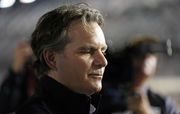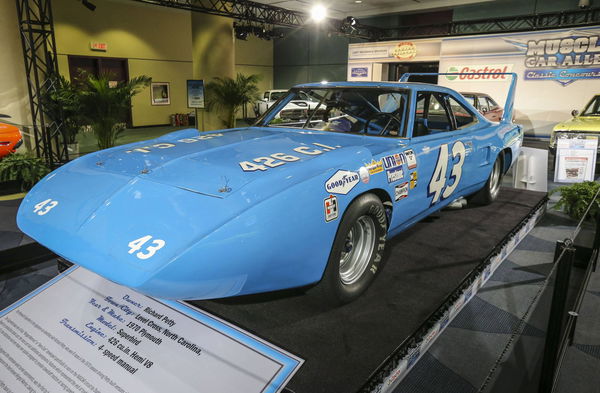
Getty
BRISTOL, TN – AUGUST 17: Team owner, Richard Petty, stands on pit road during practice for the Monster Energy NASCAR Cup Series Bass Pro Shops NRA Night Race at Bristol Motor Speedway on August 17, 2018 in Bristol, Tennessee. (Photo by Sean Gardner/Getty Images)

Getty
BRISTOL, TN – AUGUST 17: Team owner, Richard Petty, stands on pit road during practice for the Monster Energy NASCAR Cup Series Bass Pro Shops NRA Night Race at Bristol Motor Speedway on August 17, 2018 in Bristol, Tennessee. (Photo by Sean Gardner/Getty Images)
Back in the days of the 60s and 70s, NASCAR had their drivers race at famous courses like Watkins Glen and Riverside. Unlike the current oval courses, these were a bit different, and undoubtedly more challenging. These road courses featured twists, turns, elevation changes, and varying surfaces. Typical racing metrics like speed and number of turns were often altered due to this. Apart from this, precise braking skills were also an important parameter of racing back then. And who would know that better than NASCAR’s royalty Richard ‘The King’ Petty. The veteran sat down with his former crew chief Dale Inman and identified the challenges drivers had to face at his time.
Watch What’s Trending Now!
Richard Petty didn’t have different cars for different road courses
Owing to the change in tracks and the Next-Gen car, Richard Petty’s time sees a difference in racing patterns today. Unlike the cars of today which are designed with aerodynamic features for optimal performance on different types of tracks, drivers in Petty’s time had the same car for every road course. In the 1970s, NASCAR cars reportedly had larger wheelbases and were less aerodynamic.
ADVERTISEMENT
Reminiscing his days on the NASCAR tracks, Richard Petty, on being asked about his biggest challenge on road courses back in the day, revealed, “We didn’t have road race cars. It was one of those kind of deals where we run stiffer springs on the right side and softer springs on the left side. For the regular tracks. We just changed springs, put ’em on the other side, because most of the races was to the right. Basically you run the same car everywhere you run.”
Fan Question: What was the biggest challenge on road courses back in the day?
Via X user, @Rachel_McD12.
Hit the link below to watch the full race recap from this past weeks race at COTA and answers to more fan questions. https://t.co/taj8Zk7Hf1 pic.twitter.com/jjTIAzCQl6
— Richard Petty (@therichardpetty) March 28, 2024
To this insightful revelation, Inman added, “Our big race years ago was riverside, first race of the season. I don’t know, probably the first six or seven, or I don’t know how many races. But Richard certainly tore the transmission out and it was just a stock transmission. Finally we got race transmissions for road courses, and we won some races out there.”
ADVERTISEMENT
Top Stories
Ross Chastain Labels NASCAR Driver “The Most Punchable Face” to Excuse Himself Over Punchgate Controversy

Jeff Gordon’s NASCAR Rival Issues Public Verdict Years After His Apology

Richard Childress’ Champion Driver Joins Forces with HMS Crew Chief to Make Last Minute Chili Bowl Entry

Ross Chastain Recalls the Relentless Grind That Kept His NASCAR Dream Alive After Sponsorship Spin-off

Commissioner Steve Phelps Quits NASCAR Days After Getting Exposed in Lawsuit Trial

ADVERTISEMENT
The transition of NASCAR cars from King Petty’s era to the modern day
NASCAR cars during Richard Petty’s time lacked focus on performance enhancement facilities. As safety concerns and performance demands grew, so did the modifications. With a gradual shift from a strict manufacturing of stock cars for racing, the 1970s saw a focus on aerodynamics. Cars like the 1970 Plymouth Superbird were manufactured. These cars started getting recognized for their distinctive high rear wings and elongated noses. These modifications aimed to reduce drag and increase speed on the superspeedways.
Cars in the 1970s were boasted with powerful engines. Carburetors, engine tuning, and exhaust systems took precedence in expectations of better performances by the drivers on the tracks. Fast forward to today, NASCAR’s Next Gen Cars are sleek, purpose-built beasts combining safety, performance, and aerodynamics. Carbon fiber bodies, independent rear suspensions, and fuel injection systems majorly define the modern era.

Imago
Feb. 15, 2014 – Toronto, ON, Canada – TORONTO, ON – FEBRUARY 14: TORONTO, ON – FEBRUARY 14: TORONTO, ON- FEBRUARY 15 – Richard Petty s 1970 Plymouth Superbird race car on display in Castrol s Muscle Car Alley at the Canadian International Auto Show in Toronto February 15, 2014. David Cooper/Toronto Star PUBLICATIONxINxGERxSUIxAUTxONLY – ZUMAt14 Feb 15 2014 Toronto ON Canada Toronto ON February 14 Toronto ON February 14 Toronto ON February 15 Richard Petty S 1970 Plymouth Race Car ON Display in Castrol S Muscle Car Alley AT The Canadian International Car Show in Toronto February 15 2014 David Cooper Toronto Star PUBLICATIONxINxGERxSUIxAUTxONLY ZUMAt14
ADVERTISEMENT
It is safe to say that NASCAR has come a long way since then!
ADVERTISEMENT
ADVERTISEMENT
ADVERTISEMENT

